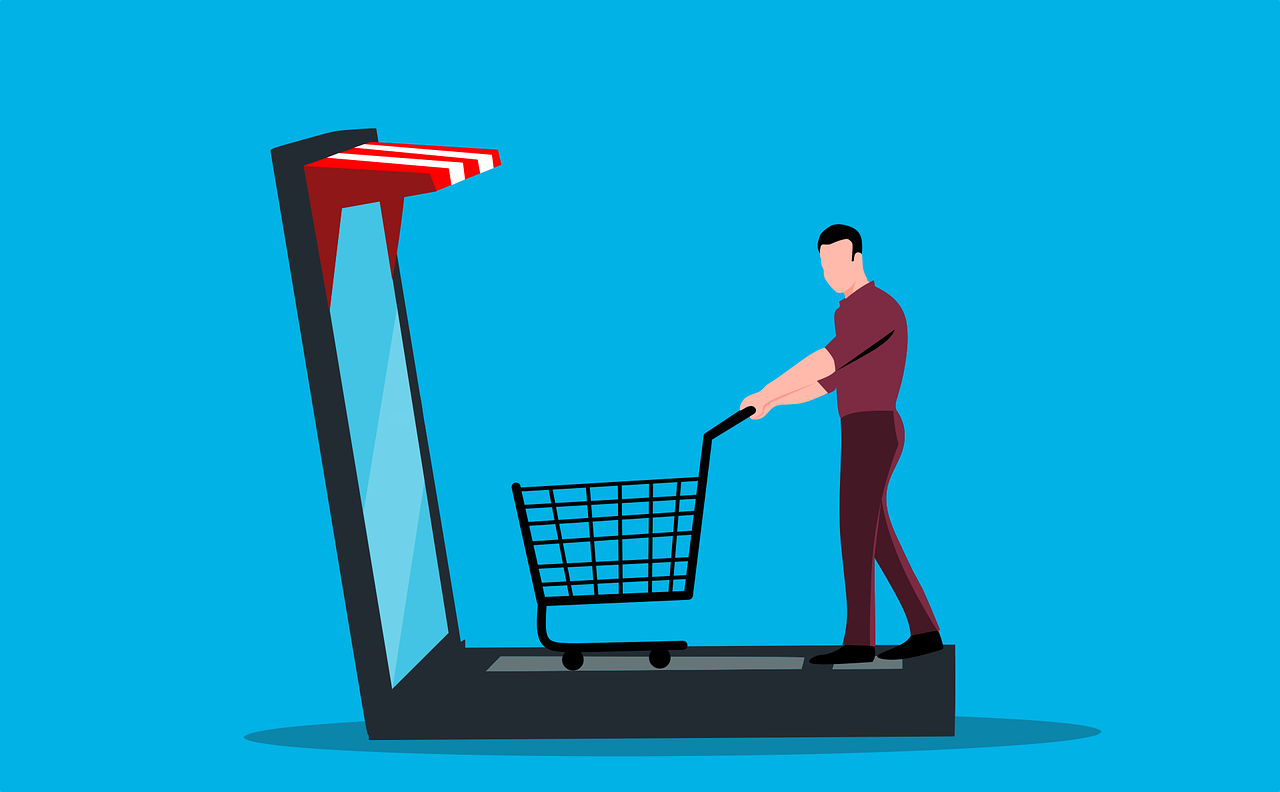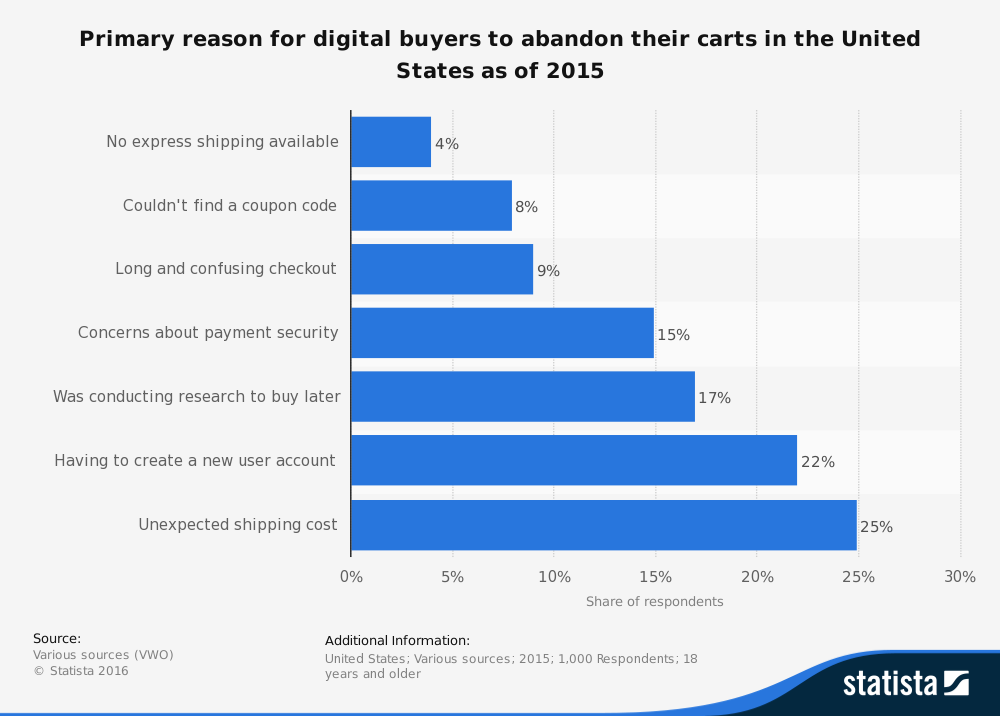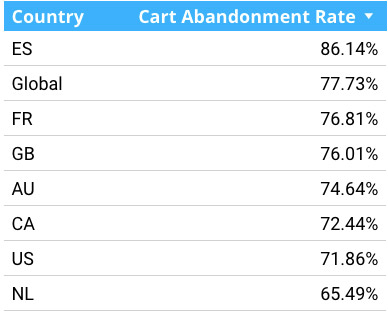After launching a new marketing campaign, I looked at the metrics for my eCommerce website and noticed that something seemed off. My traffic was steadily increasing as planned, but my sales weren’t. In fact, I noticed that a larger number of people than usual were leaving my online store without completing their purchases.
Compared to other KPIs, my shopping cart abandonment rate (CAR) was abysmal. After some initial panic and a little detective work, I discovered that the culprit was a glitch in the software I was using for the checkout process. In addition to that issue, my low-cost server was also unprepared to handle the sudden influx of traffic that my email marketing campaign generated.
I’ve since migrated my site to a more reputable, all-inclusive eCommerce platform with dedicated resources, built-in safeguards, and tech support. My store was back up and running within a few days, but the damage to my brand reputation took longer to repair.
Let’s take a look at some practical tips to help you avoid these same shopping cart abandonment issues.

The Impact of Shopping Cart Abandonment
Like many people trying to launch a startup on a limited budget, I was looking for ways to save money. I decided that I could go with a DIY website builder and add whatever plugins I needed. That included a free – apparently unsupported – third-party shopping cart plugin.
I also opted for a “free” hosting plan, which meant shared resources that were inadequate for my purposes and expected traffic. Going cheap with hosting plans and web builders could end up costing you even more. Instead, according to web developer Nathan Finch of Best Web Hosting Australia, you should look for secure hosts that provide SSL certification and other necessities by default.
“Some website builders may include SSL certification by default, or the hosting service that you will use for your website may include it as a bonus as well,” says Finch.“SSL certification is necessary to show your visitors that your website is secure and to comply with certain international regulations, like the GDPR.”
Unfortunately, I made the same mistake as others who are new to eCommerce. I spent more time worrying about appearances and less about performance. I had a slick-looking site that couldn’t handle the business I worked so hard to attract.
Not only does any delay or technical glitch make you look unprofessional, it will impact everything from your inventory to how search engines evaluate and rank your website. Google and other search engines increasingly consider user experience (UX) when ranking websites. Shoppers also look at customer reviews before deciding on a particular brand, and consumers will not hesitate to leave a bad review when they have an unpleasant experience.
In a digital business environment, professionalism and reliability are everything. The internet is filled with subpar vendors and scammers. If your website isn’t secure and performing flawlessly, especially when it’s time for customers to purchase goods and services, you’re dead in the water.
However, performance isn’t the only reason people will leave your website in the middle of a transaction. Some people are merely conducting research before making a commitment. Others don’t have credit card info or coupon codes at hand. Shoppers will also abandon a cart if the process is too long or confusing, which is why it’s important to invest in invoicing software that comes with crucial features like automatic payments for repeat customers.
In addition to people dumping their carts and leaving your website, shopping bots are a recurring problem. These are malicious technologies created for the express purpose of overloading carts and crashing eCommerce sites.
Whatever the reason behind your shopping cart abandonment rates, the impact goes beyond lost revenue and reputations. Possible outcomes include:
- Artificially reduced inventory – some products may appear as unavailable
- Lower conversation rates
- Reduced ad CTR. Digital marketers and cookie trails could actually be targeting ads to cold or unqualified leads and bots who will never make a purchase
- Inaccurate analytics, which includes everything from how well your marketing campaign is working to sales forecasts and trends
Inaccurate data, flat sales, and a damaged reputation waste time and money. Eventually, they’ll kill any hope of creating a viable online enterprise.
Shopping Cart Abandonment Stats That Might Surprise You
Shopping cart abandonment is a huge issue in eCommerce. On average, about 88% of shoppers abandon their carts. That means only 12% of shoppers followed through with a purchase.

Although technical glitches are a big problem, a main reason for cart abandonment is hidden costs that don’t appear until checkout, turning the shopper off when they realize their purchase will cost much more than originally listed. Nearly half of all consumers will bail on a sale if their total contains unexpected taxes, high shipping costs, and other financial disincentives.
Surveys also show that more than 85% of mobile shopping carts are abandoned before a sale is completed. Overall, eTailers realized more than 35% improvement in conversion rates just by improving design and flow at checkout.

The Art of the Shopping Cart
Often, an issue with shopping cart abandonment and overall conversion rates is a symptom of other underlying problems. When assessing website performance, consider CAR alongside other KPIs like Average Order Value, unique and returning traffic, and Website Conversion Rate.
Here are several proven ways to reduce abandonment rates and boost sales:
Streamline the checkout process
Few things are worse than a needlessly complex or lengthy checkout process. The first thing you could do to improve your CARs and by extension, your UX, is to make the checkout process secure and efficient.
Use a short, one page process, with steps that are clearly delineated. Avoid using any form fields or other distractions that aren’t critical to completing the transaction, and add a function that highlights any missing or incorrect information so it can be quickly addressed.
Offer a guest option
One of the leading causes of abandonment is the requirement for users to create an account. I must admit that I’m guilty of this myself, especially if I’m in a hurry, or it’s for an infrequent purchase. Most of us have enough logins to remember without having to create a new one each time we want to make a purchase.
This issue can be completely avoided by allowing an option for visitors to check out as a guest. You could also include an option to login with an existing account, such as Google or Facebook, which most people have already logged in and ready at any given time.
Prioritize mobile design
Not only do mobile devices account for a higher rate of abandonment, they are also increasingly the platform of choice for shoppers. The trend toward mobile-first indexing for SERPs means mobile-first design is imperative for a positive user experience and increased web traffic.
Most web builders make it easy to create mobile-first design, and you won’t have to worry about how your pages will look on a PC or tablet since most content that looks good on a mobile screen performs just as well on larger screens and monitors. The same cannot be said if you optimize your design and build for PCs without mobile optimization.

Optimize for speed
Speed should be a focus with any web platform. You can get around this problem by optimizing your website with smaller files, fewer images, and a clean, uncluttered layout. Use only critical elements when designing your web pages, and always choose a hosting platform that offers maximum up time and speed. There are some very reliable platforms that offer low-cost hosting and premium level performance.
Provide multiply ways to pay
Let’s face it, people love options. They also crave security. By offering alternate payment options that are trusted, and secure, such as PayPal, MasterPass, and Amazon (in addition to credit and debit cards), you’ll increase your customer base and average sales per transaction. You could also offer payment plans for purchases over a certain dollar amount.
Whenever possible, offer free or low cost shipping. If you’re a smaller shop, this can be tailored to alternate shipping options, such as a choice between standard shipping through the USPS and overnight or FedEx for a higher cost. You could ship for free if the order is over a certain amount.
Remove any doubt
Sometimes, people want to make a purchase, but something is holding them back. Maybe everything else is in order, but they’re bothered by a lack of information. Perhaps the product images or specs are missing or unclear.
You can alleviate a lot of this confusion with realistic images of actual products rather than stock photos, adding an FAQ section and customer reviews to each product page, and placing contact information in several locations on your website. In the event that a cart is abandoned, an automated email asking for feedback or providing a reminder will often bring them back.
Be transparent
One of the most important things an online merchant can do is to promote trust. Be transparent by setting all pricing up front, offering a clear return policy documented in writing, and making customer service available at all times and from a range of platforms.
Also, be up front about and anticipated issues. For example, if timely delivery might be an issue due to supplier limitations, make sure your customers know that in advance. Offer order tracking, and resolve any problems as soon as possible.
Final Thoughts
Customer experience is critical to your success as an online business, and the checkout experience is a significant part of this. Our goal is to provide you with information about common reasons for shopping cart abandonment and some actionable steps to avoid them so you can be one of the success stories of eCommerce shops retaining loyal customers and growing your online following.